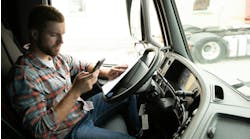In my previous article “The Big Question: Cameras on the Driver or Not?”, we explored the “Not”. In this column we will explore the reasons FOR driver facing cameras which are many.
Why Are Internal Driver Facing Cameras Important?
There are two main reasons to have a driver facing camera rather than just a forward facing road camera. First, with ever more aggressive plaintiff attorneys, you can protect your driver and fleet in litigation by proving you were doing the right thing. Secondly, fleet leadership wants to be as proactive as possible in eliminating as much risk on the road as they can. The majority of companies who have deployed a video safety program have two cameras.
Video Evidence
In litigation, it is the plaintiff attorney’s job to make the fleet and driver look as bad as possible or make him/her as good as possible. If a prosecutor is involved it is typically their job (in most cases) to make the fleet and the driver look bad. Having an internal video perspective can change the evidentiary dynamic by allowing a fleet to provide video that the driver was doing the right thing. They do this because the inward facing camera provides unambiguous insight into what the driver is or was doing in a collision or a risky situation. Or better yet, it is quite possible you may not even have to go any further than just saying you have the video exonerating your driver and company, or by showing the video to the opposing counsel. Boom, lawsuit dropped!
Reducing Risky Driving
As previously noted, the majority of companies who have deployed a video safety program have two cameras. They do this because the inward video perspective allows you to provide very constructive feedback to drivers who demonstrate safe, professional driving. It also provides insight to drivers who may have become complacent, picked up a bad habit or two that needs to be addressed, or by identifying for coaching purposes common sources of distracted driving such as texting, cell phone or smartphone use, looking at paperwork, etc. The safer the driving the lower the chances are for an accident.
Driver Buy-In
We are all sensitive to driver reaction. They are an extremely valuable if not the most valuable part of every fleet. It is stated by those in the video safety industry that the number of drivers who actually are opposed to working for a fleet with internal facing cameras, or who actually quit because of them, is not that high - and are often those drivers that present the most risk for the fleet. Furthermore, it is stated that drivers who have been on a two camera safety program for a while that the feedback that is heard often is that they appreciate the help. They acknowledge that they didn't realize some of the things they had started to do, and are grateful to have that insight - helping them by preventing issues down the road by being more and more of an effective and safer driver. A well thought out introduction to how cameras are there to protect the driver is key to a completely successful roll-out.
In conclusion, video technology is uniquely capable of providing insight into the realities of today's driving environment - whether it's one, two, or more cameras. It has a massive ROI and can reduce your fleet liability costs significantly right out of the gate. Fleets have the latitude and the supplier options today to be able to choose the video solution that is right for them, their drivers, their budget, and their leadership team. Every fleet should be the very safest fleet possible depending on the business constraints and requirements unique to them. My recommendation would be to keep your options open regarding which video solution you may want to choose: a single forward-facing camera, a forward and driver facing combination, or the ability to grow into a three or four camera solution adding left and right sides of the truck. You are the customer so you’re in the position to make sure the solution you select not only meets your requirements today, but also down the road. Video is a game changer making everyone on the road safer. I applaud all fleets for taking the very positive step forward of bringing a video technology solution to their fleet.


